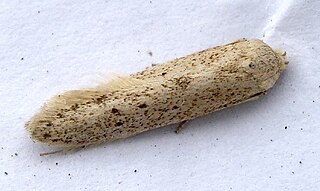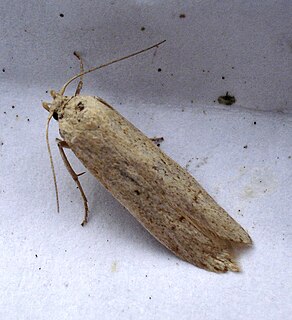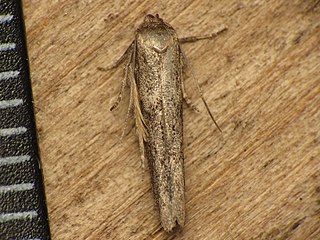
Batrachedra is the largest genus in the moth family Batrachedridae, with representatives all over the world. The early stages of most species are unknown. The genus name is derived from the Greek words batrachos, 'frog', and edra, 'seat', referring to the frog-like resting posture of the adult moths. As of 2018 at least some 114 species are known to belong to the genus.

The Blastobasidae are a family of moths in the superfamily Gelechioidea. Its species can be found almost anywhere in the world, though in some places they are not native but introduced by humans. In some arrangements, these moths are included in the case-bearer family (Coleophoridae) as subfamily Blastobasinae. The Symmocidae are sometimes included in the Blastobasidae as subfamily or tribe.

The Momphidae, or mompha moths, is a family of moths with some 115 described species. It was described by Gottlieb August Wilhelm Herrich-Schäffer in 1857. These moths tend to be rather small with a wingspan of up to 21 mm. The wings are held folded over the body at rest. The larvae are concealed feeders, either as leaf miners or within seeds or stems.

Megacraspedus is a genus of moths in the family Gelechiidae, found primarily in the Palearctic.
Auximobasis is a genus of the gelechioid moth family Blastobasidae. It is sometimes included in Blastobasis.

Blastobasis is the type genus of the gelechioid moth family Blastobasidae; in some arrangements these are placed in the case-bearer family (Coleophoridae) as a subfamily. Within the Blastobasidae, the subfamily Blastobasinae has been established to distinguish the Blastobasis lineage from the group around Holcocera, but the delimitation is not yet well-resolved.

Cosmopterix is a large genus of moth in the family Cosmopterigidae.

Blastobasis lacticolella is a species of moth of the family Blastobasidae. It was introduced in western Europe and is now reported from the Netherlands, Great Britain, Ireland and Madeira.
Blastobasis vittata is a moth of the family Blastobasidae. It was thought to be endemic to Madeira but is now known to inhabit the Netherlands, France, the Channel Islands, England and Northern Ireland.

Blastobasis phycidella is a moth in the family Blastobasidae. It is found in most of Europe.

Blastobasis decolorella is a moth in the family Blastobasidae. It is found on Madeira and in Portugal. Records from England and possibly also the Netherlands are based on misidentifications of Blastobasis lacticolella.
Blastobasis desertarum is a moth in the family Blastobasidae. It is found on Madeira and the Azores. The species was recorded from greenhouses in Berlin in 2005, where it was incidentally introduced.
Blastobasis lavernella is a moth in the family Blastobasidae. It is found on Madeira and in Spain.
Blastobasis maroccanella is a moth in the family Blastobasidae. It is found on the Azores, Madeira and in Portugal, Spain and Morocco. It was recently reported from California in the United States.
Blastobasis rebeli, the marsh dowd moth, is a moth in the family Blastobasidae found on Madeira. It was first recorded from Hampshire, Great Britain in 1998 and there have been subsequent records from the same area and nearby, as well as in West Sussex.









